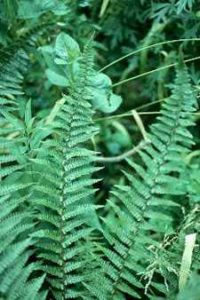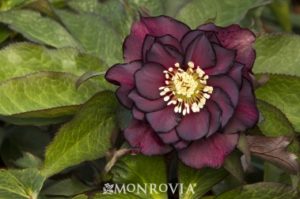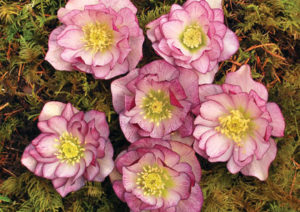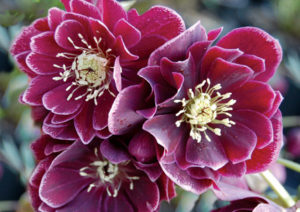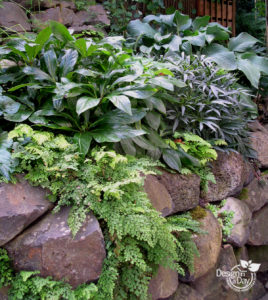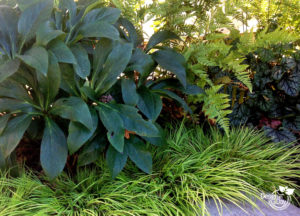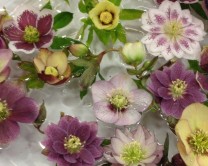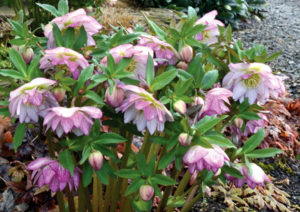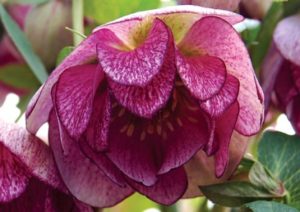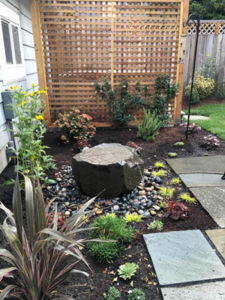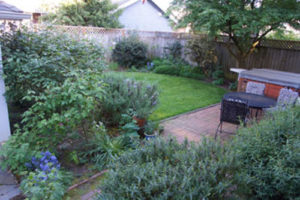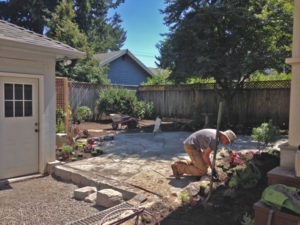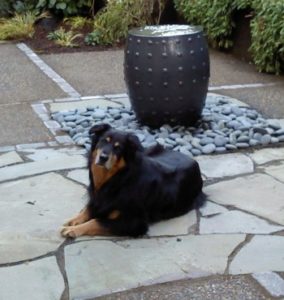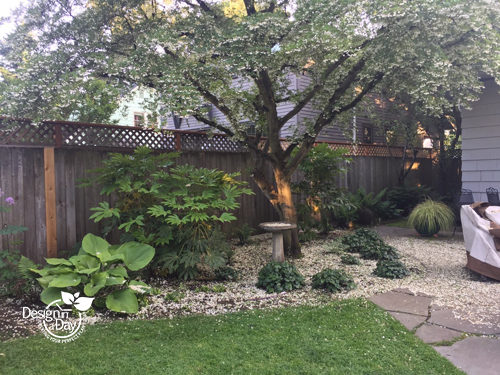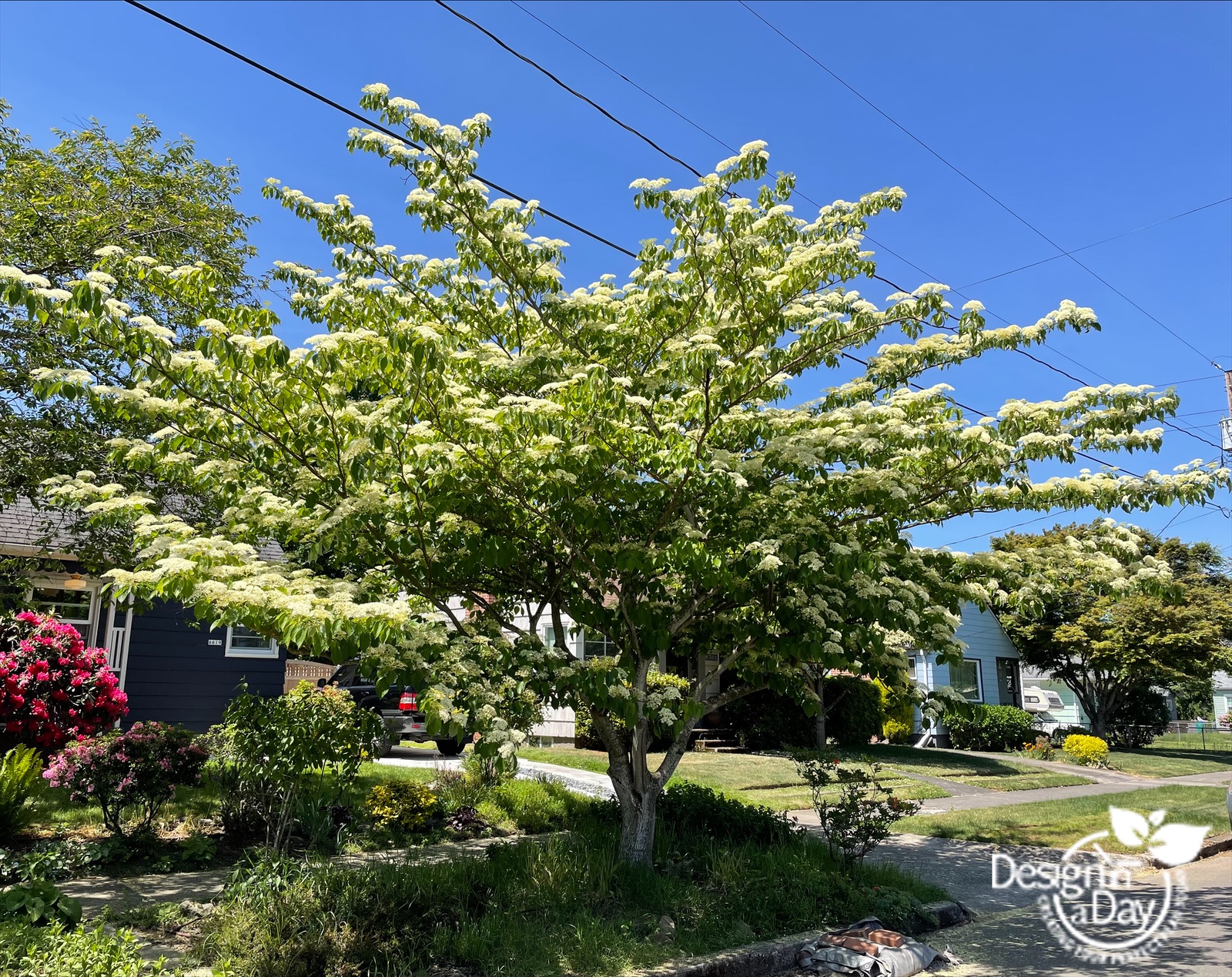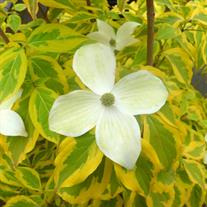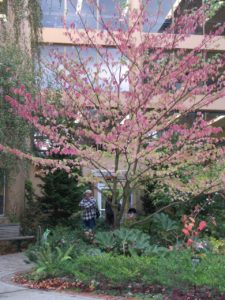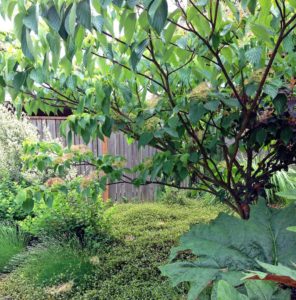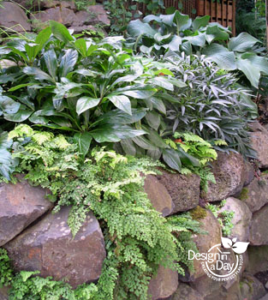
Himalayan Maidenhair Fern – Adiantum venustum creeps through rockery. Photo is from one of my Willamette Heights Landscape Designs in Portland, Oregon.
Ferns for Portland Landscape Designers
I’ve been following Judith Jones and her career as a fern expert extraordinary before social media existed. She’s been my fern guru for 20 years and I’ve tried to catch her lectures when she comes to Portland at Joy Creek Nursery, HPSO plant sales and garden shows. My favorite Judith sighting was at the Seattle Flower and Garden Show when her show garden as the set for the Flintstones. She was dressed as Wilma complete with a bone in her hair. There was a dozen or more 8’ tall tree ferns and a 20’ tall volcano. It looked like a real tropical fern forest. It’s still my favorite show garden of all times. She and her nursery Fancy Fronds have been my source for ferns in my designs.
She gave a special program for ANLD Portland Landscape Designers the other evening. She has continued to evolve and had new plants for me to consider as well as highlighting my old favorites. It was such a pleasure to see her and learn more about ferns for landscape designers.
Client Charmer – Tracys Hybrid Maidenhair – Adiantum x tracyi
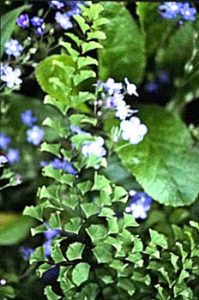
Tracys Hybrid Maidenhair – Adiantum x Tracyi
Is it possible to have a new fern? This maidenhair was discovered in the 1900’s instead of 2000 bc which makes it new in my book. Tracyi is a natural cross between two California native deciduous Maidenhair ferns and oddly enough it is evergreen. Clients like a plant with long seasonal interest. The leaf or pinnae is cute, it has little dimples in the edge of each leaf. The plant is a foot tall and like many Maidenhair ferns, the texture of the plant is what people notice most. The best place to buy it is Judith herself at www.fancyfrondsnursery.com I will list it in the shade category but many maidenhair fern can take some sun and become low water plants over time. Typically, they are listed for moist shade.
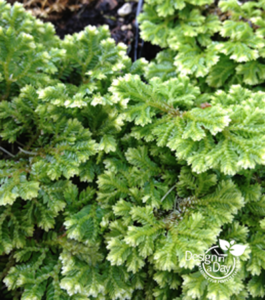
Kraus’ Spikemoss – Selaginella Kraussiana is a low ground cover fern that is underused. Some think it isn’t cold hardy for Portland, Oregon. Not true! I have it growing outdoors in a container where it’s handled many winters. It’s thriving in boulder crevices up in Willamette Heights. Plant it where it will have good drainage and light shade.
Kraus’ Spikemoss – Selaginella kraussiana ‘Gold Tips’
My descriptive words for Spikemoss are baby chick fluffy, with evergreen piles of adorable pettable texture. Judith feels it is underused and recommends it for Portland designers. Don’t get confused and purchase Peacock moss, Selaginella uncinata because they are devoured by slugs. I’ve been using Spikemoss for years at garden shows to dress up my pottery which is how I know that the millennial generation loves it. They come running into my booth to pet the moss and ask if it is real. Spikemosses are not true mosses and are classed with ferns because they have a vascular system and moss doesn’t. I’ve used Spikemoss in between boulders and I love the effect. My advice for boulder plantings is plant twice as much as you need, use a mix of compost, clay and sphagnum moss in the crevices. Don’t plant them at the base of boulders; they won’t get enough light. Where it succeeds, it is eye catching with chartreuse fluffy fans against gray boulders. It has succeeded planted under my (containerized) Dwarf Vine Maple for 6 years so cold isn’t an issue.
Narrow Planting Beds
Ferns for Narrow Planting Beds – Narrow Golden Scaled Male Fern-Dryopteris affinis ‘Stableri’ which has no crests and ‘Stableri Crisped’ which has curled and crimped pinnule margins. Think amazing texture! Judith suggests these for narrow planting strips in general and in front of tall fences in particular. My experience is that builders and concrete contractors often create front walks that only leave a skinny strip for plants.
Imagine a 6′ tall fence with, you guessed it, about 15” to plant in. It’s a problem for homeowners and even designers struggle finding plants that fit this situation. Jack hammering out the front walk and starting over with a new one is the best thing if there is space for other options and budget. The rest of the time we find the right plant that will fit that location for years without our clients needing to do much. Can you imagine a fern trimmed into a lollypop? We are trying to avoid that sort of business!! Sigh…….. These handsome ferns could live for decades in that narrow area as long as the soil drains reasonably well. These ferns are also my favorite for visually making the fence subordinate instead of prominent. The narrow vase shape also makes them perfect contrast partners to plants with large leaves like Hosta or Fatsia in larger planting beds.
Foundation Plants –
Sword Leaf Holly Fern – Polystichum xiphophylum and Makinoi’s Holly Fern – Polystichum ‘Makinoi’
These two ferns could become your new regular use plants in designs. They are evergreen, not as tall as many ferns and look good in foundation plantings. Place them in partly shaded and shady areas.
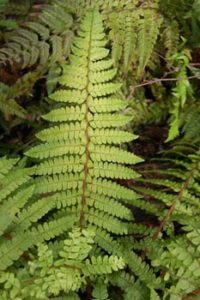
Makinoi’s Holly Fern – Polystichum ‘Makinoi’
Sword Leafed Holly Fern – Polystichum xiphophylum is neat and small at 15″ tall.
Makinoi’s Holly Fern – Polystichum ‘Makinoi’ – Olive, straw gold and russet fern with lustrous fronds is beautifully different than other ferns. Judith says it like this: “There is a reptilian sheen to the olive-green linear-lanceolate fronds which blends subtly into the varied straw to chestnut colored scales cloaking the supporting framework.” It’s typically a 2-footer and evergreen or ever olive. Some filtered morning light is okay but this fern is not for sunny areas.
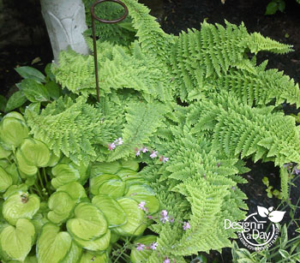
ANLD Member Rick Hansen design Arachniodes Standishii – Upside Down Fern in 2015 Designers Garden Tour. Note the color echo achieved by matching the mid green of the fern with the mid green leaf edge of the hosta. See the contrast from the ruffled texture of the fern with the smooth hosta leaf.
Big Drama Fern
Upside Down Fern – Arachniodes Standishii – It’s not an upside down plant but the way the little pinnae are organized is opposite of all the other Arachniodes ferns in the world. What I care about is that it is cold hardy here (native to Korea and Japan), has an over the top lacy pattern and is easy to grow. It’s semi evergreen. It can take a little direct morning sun, typically place it in filtered shade with some deeper afternoon shade. Plant it in front of other plants for a peek through the lace curtain effect. It can eventually get large (4′ tall and wide) and I am trying mine on the north side where it will get sun until noon in mid June. I’m pushing my luck a bit so we will see if it scorches and if so how long it takes to recover.
After the lecture, I bought plants. Even in my near senior status I felt that good old plant lust rise to the surface. I usually don’t indulge in buying plants at lectures. Managing all aspects of my landscape design business doesn’t leave me a lot of time for my former hobby of gardener and plant enthusiast. I must be careful that I don’t kill plant material purchased in a state of amnesia about the reality of my life. I bought these 5 ferns: Tracys Hybrid Maidenhair – Adiantum x traceyi, Narrow Golden Scaled Male Fern Dryopteris x complexa ‘Stableri Crisped’, Arachniodes Standishii, Upside Down Fern, Makinoi’s Holly Fern – Polystichum ‘Makinoi’, and have lost the tag on the last one. It’s clearly a Holly fern of some kind.
Buy ferns from Judith
My clients and I buy ferns directly from Judith off her web site or via an email. I like buying from her and get loads of advice and information when I need it. They arrive in great shape and are mostly sized between a 4” plant and a quart. If you want bigger sizes, contact her before the spring or fall HPSO plant sale and she can bring them down for you. Your clients can buy directly from her too.





